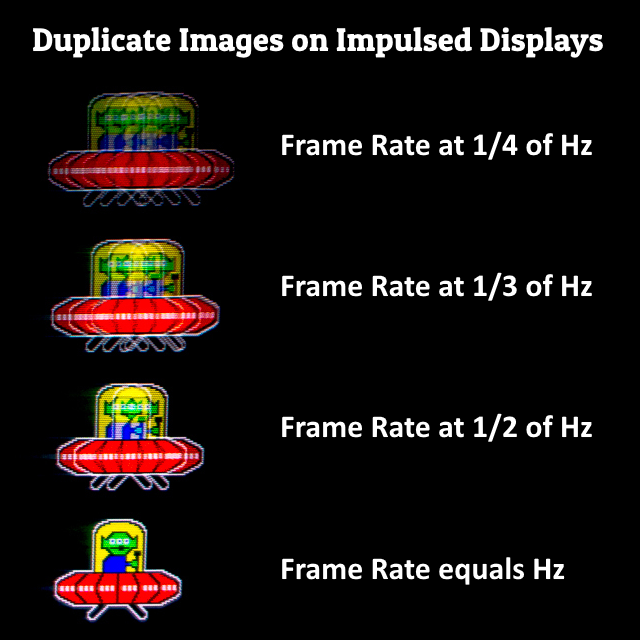[This thread is interesting only to people who are familiar with CRTs and plasmas and the 30fps double-image effect]
Remember the CRT 30fps at 60Hz effect? I've reproduced it in software-based BFI with a new custom easter egg TestUFO modification.
TestUFO Animation: Software-Based Double Image BFI Demo
(Look at the 2nd UFO for a double image effect similar to CRT 30fps at 60Hz)
Click on this to watch this full screen:
Best performance occurs with a desktop browser that is correctly running at framerate=refreshrate. Observe the 2nd UFO. It has a duplicate image, similar to CRT 30fps at 60Hz.
To emulate is correctly via software-based BFI required me to run at 1/4 frame rate. Right now, the animation is emulating a half-refresh-rate CRT, and you need half-framerate to get double images, so it requires quarter-frame rate (combined). So 15fps on 60Hz, for a software emulation of the double-image effect.
For impulsed displays, this is normally how things look:

This happens at all refresh rates. We already know it also occurs at 60fps at 120Hz strobed (ULMB, ELMB, LightBoost, etc). Even 120fps on a 240Hz impulsed/strobed display still show double images. And 60fps at 240Hz impulsed has quadruple images.
Assuming your browser runs it well, this works on all ordinary non-strobed LCDs / OLEDs.
- Runs 15fps on 60Hz LCDs
- Runs 30fps on 120Hz LCDs (best emulation of CRT 30fps at 60Hz)
- Runs 60fps on 240Hz LCDs
If you have a higher-Hz display, these below links look MUCH better to demo:
TestUFO BFI Double-Images For 120Hz+
TestUFO BFI Double-Images For 240Hz+
As far as I know, this is now the world's first software-based demo of the equivalent of a CRT 30fps@60Hz double-image effect, as long as your browser can run framerate=Hz.
How did we make it work?
It's a 4-frame software-based 2-repeat sequence of 1 visible, 1 black frame, using a cadence of 100%,0%,100%,0% (of the same static frame) per 1/15sec on a 60Hz monitor. That generates a software-based double-image effect on nearly all display technologies (LCD, OLED, DLP, etc). The motion of human eye-tracking is actually the main cause of LCD motion blur, clearly demonstrated in animation demo http://www.testufo.com/eyetracking ...GtG pixel response is NOT the main cause anymore, it's static pixel visibility time from sample-and-hold. Common LCD motion blur is mathematically directly proportional to pixel visibility time (excluding GtG time), as explained in Blur Busters Law: The Amazing Journey To Future 1000Hz Displays as well as Pixel Response FAQ: GtG versus MPRT.
Fundamentally, all common impulse-based technologies are essentially a form of per-pixel BFI. CRT phosphor dot, for example, it illuminates nearly instantly and then fades after with phosphor decay.
Simplified Motion Blur Mathematics
For the purposes of this post, terminologically we will treat BFI and CRT impulse scanning as an overlapping venn diagram. CRT is terminologically a "phosphor-trailed rolling-scan BFI" as BFI doesn't need to be engineered as full frames, or even a 50%:50% refresh-cycle-granularity BFI. Normally we don't call CRT as BFI, because it's a natural inclusion. But we will, for the purposes of this post (from a human vision perspective), treat CRT a BFI behaviour that is essentially defacto 1%:99% ON:OFF per-pixel-based BFI. This depends on how slow/fast the CRT phosphor is, but you get the idea, brief pixel flash, lots of black time.
Go play with BFI with the settings at the top of the Software BFI demo. BFI and CRT venn diagram overlaps. Think of LCD computer refresh cycles as refresh-granularity persistence. 240Hz displays are like phosphor persistence in 4.2 millisecond increments. Very educational to learn!
Here are some great more BFI demos:
TestUFO Animation: Variable BFI -- Demos variable amounts of blur against full-frame-rate
TestUFO Animation: Double Images -- Demos double image effect
TestUFO Animation: Triple Images -- Demos triple image effect (test at 120Hz+, flickers much 60Hz)
TestUFO Animation: Blue Frame Insertion -- Demos that blank frames don't need to be black
NOTE: For best TestUFO animation performances, make sure to run this in a browser capable of running framerate=Hz, though multimonitor sometimes interferes. To minimize stutters during this demo on some computers, you may need to close all tabs and run only on primary monitor. May need to test a different browser, FireFox vs Chrome.
For more reading about display behaviours, see Blur Busters Law: The Amazing Journey To Future 1000Hz Displays.

